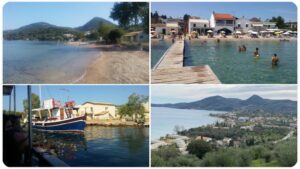GO HERE TO SEE THE PHOTOS
Happy people, happy waterfowl
I am telling you, I had the most serene walks in Kastoria. Sitting on a bench and gazing out at the stunning landscape became my number 1 favourite pastime during Greek Easter, earlier this month.
And I envied the locals so much, for having these alluring paths to walk on, at the edge of Lake Orestiada. The lakeside front is 15-kilometre-long!
Out of town, the lakeside path is often pedestrian, beckoning as an earthly paradise to nature lovers. Plane trees everywhere, the bird song rich, and the ambiance is magical.
Kastoria is a town in west Macedonia (northern mainland of Greece) and it is famous for its fur merchants. It is a town of vast history. Firstly inhabited in neolithic times, it was first conquered by the Romans, then the Byzantines, the Bulgarians, the Normans, the Franks, the Serbs, and the Turks, before finally becoming part of Greece in the beginning of the 20th century.
The old quarter is called Doltso and it is built on a hill. Its lanes with many antiquated estate mansions and old buildings with black wooden beams made it a pleasure to explore.
Sadly, our tour saw us out of town in the mornings and back to Kastoria in the late afternoons every day at a time when the folklore museum and other places of interest were closed for the day. But we did manage to visit the town’s aquarium, which is the largest freshwater aquarium in the Balcans. It exhibits fish and other organisms that are indigenous, endemic or foreign to Greece, living in lakes and rivers.
I will post photographs from the aquarium and the tiny yet quaint and historical Monastery of Panayia Mavriotissa another day. Both are situated on the lake.
We missed the chance to visit the ‘Dragon’s Cave’, a cave by the lake with rich stalactite and stalagmite decoration, underground lakes, halls, corridors and tunnels.
Oh well, I am not all that gutted, though, since we managed to visit the neolithic settlement by the lake that depicts life in the area some 7,500 years ago! It was enthralling to visit the little huts, some of them on stilts over water. Inside, there were human figures made of clay and replicas of everyday items that have been found at the excavation site nearby.
Enchanting and educational stuff. Go here to check out my post about this amazing place!
Just like Granny Antigoni used to make…
I’m still amazed. Last weekend, I managed to recreate my Corfiot granny’s pastitsada! It tasted just the same with Spetseriko and a couple extra spices. Pastitsada is a traditional Corfiot dish made with pasta, beef and carrots in a tomato sauce.
I went for spaghetti instead of the traditional pasta number 2, though. A personal preference, and it was just as yummy. I’ll have to make it again with the proper pasta and blog the recipe for you, guys. Watch this space! And, see below for more info on the secret spice mix from Corfu!
Here’s something you may not know…
There is a secret spice mix dating from Corfu’s Venetian occupation days, and it is called Spetseriko! It is delicious and aromatic in tomato sauces, such as in pastitsada, and also in pastichio.
This secret spice mix used to be made by the pharmacists on the island, and there is one pharmacy in town today that still makes it from an original recipe!
GO HERE to read my post about Spetseriko. It contains a recipe to make it at home too. And, if you plan to visit Corfu town, you’ll get to hear which pharmacy you need to go to to get your own bag of genuine Spetseriko!
YOU KNOW WHAT THEY SAY… SHARING IS CARING! Tweet this to spread some love:
Interested in travel, food and books from Greece? Here's a blog you will love! #Greek #blogger #writer Share on X
3 FREE books for you! Sign up below to receive them instantly!
NEW! Clean Christmas romance. Single mother Cathy Roussos gave up on love long ago, and veterinarian Alex Rallis doesn’t believe in it, but one magical Christmas on a Santorini farm might just change everything…
Check it out on Amazon Read a FREE sample!
A clean romantic suspense short read with an unreliable narrator that’ll keep you guessing! Vera is losing her mind over famous actor Yannnis Ksenos, except, she isn’t just a fan… Now, she plucks up the courage to ring his doorbell… Visit Amazon










